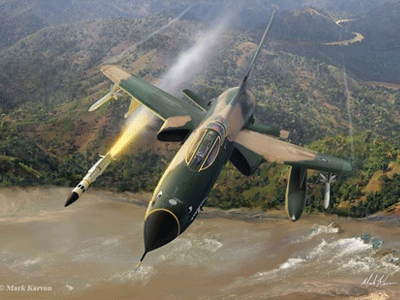On 19 July 1966 12 camouflaged, and bombless, F-105D Thunderchiefs of the 355th Tactical Fighter Wing’s 354th Tactical Fighter Squadron were detected by ground radar flying over Tarn Dao. Armed with missiles only, these machines passed north of Hanoi, bound for Noi Bai airfield. Having headed north unencumbered by bombs, the F-105s were almost certainly on a MiG-hunting mission. They succeeded in their aim of provoking the VPAF’s fighter force into action, for at 1450 hrs the 923rd Fighter Regiment’s Nguyen Bien and Vo Van Man took off from Noi Bai in their MiG-17s to intercept the incoming USAF fighter-bombers.
The communist pilots quickly engaged four of the F-105s, and Nguyen Bien opened fire. The American pilot targeted by Bien successfully evaded his opening rounds, however, and in turn pulled in behind the MiG. Despite firing numerous bursts of cannon fire at Bien, the Thud driver’ failed to register any hits.
East of the base Vo Van Man (flying an overall snake-green MiG-17F ‘Fresco’) latched on to the tail of Bien’s pursuer and fired two well-aimed bursts of cannon fire into the F-105. Mortally hit, the Thunderchief (59-1755) crashed before its pilot, 1Lt Steven W Diamond, could eject. The surviving USAF pilots continued to dogfight with the MiGs, but they failed to make any real impression on the agile VPAF fighters. The F-105 pilots were also having to contend with fierce anti-aircraft fire from the flak batteries around Noi Bai.
Two minutes after Diamond had crashed to his death, a second Thunderchief was claimed by Nguyen Bien, while a third F-105 was reportedly hit by flak and exploded over Tuyen Quang. The USAF only officially acknowledge the loss of two F-105s on this sortie, the second having reportedly been downed by AAA. Both MiG-17s recovered safely at Gia Lam airfield in Hanoi
In 1966 the weakest link in the Vietnamese air defences was still its early-warning radar capability, and the lack of proper communication with fighter units. At this time, the ADF-VPAF high command had control over radar units and equipment directly responsible for the protection of important industrial and municipal centres. They had no authority at all, however, over those belonging to military districts and regional defence committees.
The problems for the fighter units were compounded by the fact that the air defence system operated only periodically. Without proper direction from the ground, pilots in most cases had to find their targets purely with their eyes. This did have its advantages though, for larger formations of enemy aircraft – say perhaps between eight and ten – could be seen from up to 15 kms away in daylight. Without radar to alert the American pilots to the fact that they had been spotted, the North Vietnamese could sneak up on the fighter-bombers undetected.
The Vietnamese had only a limited amount of airspace in which to engage their foes, for they were forbidden to enter areas protected by AAA units, or those guarded by SAM sites, unless they were returning home at an altitude of 500-600 m. Indeed, coordinated action by fighters and SAM units within the same defence area was rare. In special cases, such as in a pursuit, or if a pilot was finishing an attack, braking off from a dogfight or preparing to land, he would be given permission by the command centre to operate at a different altitude.
The risk of ‘friendly-fire’ incidents was high. In 1966 alone, defence units opened fire on their own airmen on ten occasions, shooting down two MiG-21s and badly damaging the others.
As the war dragged on, a continuous supply from China, the Soviet Union and other communist countries provided a sufficient amount of hardware. There were fighters (MiG-17/F/PF, MiG-19, MiG-21F- 13/PF/PFM/MF), radar units (P-12 ‘Spoon Rest’, P-15 ‘Flat Face’, P-35 ‘Bar Lock’ and PRV-11 ‘Side Net’), surface-to-air missiles (SA-2, SA-3, SA-7, SON-4/9, ‘Fan Song’ and ‘Low Blow’) and conventional antiaircraft artillery weapons (37, 57, 85 and 100 mm). And with an ongoing training programme for pilots and ground units, the air defences became increasingly effective both day and night.
